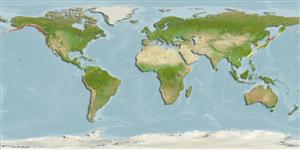Gastropoda |
Not assigned |
Lottiidae
Environment: milieu / climate zone / depth range / distribution range
Ecology
Benthic. Subtropical
Pacific Ocean: Alaska to Mexico. Boreal to tropical.
Length at first maturity / Size / Weight / Age
Maturity: Lm ? range ? - ? cm Max length : 5.4 cm SHL male/unsexed; (Ref. 95344); common length : 4.0 cm SHL male/unsexed; (Ref. 312)
Apex near center, irregular ribbed slopes. Some possess a brown colored shell with alternating brown and white checks at the edge. Other colorations of this limpet exist and can be found in the same area. Both the substrate the limpet lives and its diet determine the color of its shell (Ref. 312).
It has a shell length of 4 cm (Ref. 312). Maximum shell height at 1.5 cm (Ref. 95344). Occurs in the middle to high intertidal zone (Ref. 312); common from the low to mid-intertidal; the largest individuals are found lower on the shore farthest from effect of wave action (Ref. 310). Non-selective herbivores, consuming a wide variety of algae (Ref. 312). Commonly found in mussel beds and associated with brown algae (e.g., the sea palm, Postelsia)
Life cycle and mating behavior
Maturity | Reproduction | Spawning | Eggs | Fecundity | Larvae
Members of the order Patellogastropoda are mostly gonochoric and broadcast spawners. Life cycle: Embryos develop into planktonic trocophore larvae and later into juvenile veligers before becoming fully grown adults.
Gallivan, G. and J. Danforth 1999 Phylum Mollusca. Marine Science Institute. Http://216.239.51.104/search?q=cache:EEiLeA0OeAMJ:www2.ucsc.edu/simp/guide.pdf+Nuttalina+californica&hl=tl&gl=ph&ct=clnk&cd=8 [accessed 20/01/06] (Ref. 312)
IUCN Red List Status
(Ref. 130435: Version 2025-1)
CITES status (Ref. 108899)
Not Evaluated
Not Evaluated
Threat to humans
Human uses
| FishSource |
Tools
More information
Trophic EcologyFood items (preys)
Diet composition
Food consumption
Predators
Population dynamicsGrowth
Max. ages / sizes
Length-weight rel.
Length-length rel.
Length-frequencies
Mass conversion
Abundance
Life cycleReproductionMaturityFecunditySpawningEggsEgg developmentLarvae PhysiologyOxygen consumption
Human RelatedStamps, coins, misc.
Internet sources
Estimates based on models
Preferred temperature
(Ref.
115969): 6.1 - 12.7, mean 8.5 (based on 365 cells).
Fishing Vulnerability
Low vulnerability (10 of 100).
Price category
Unknown.
